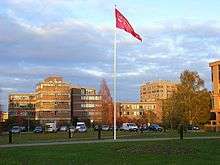University of Reading
 | |||||||||||||
Former names | University College, Reading (1892–1926) | ||||||||||||
|---|---|---|---|---|---|---|---|---|---|---|---|---|---|
| Type | Public | ||||||||||||
| Established |
1926 (university status) 1892 (as University College, Reading) | ||||||||||||
| Endowment | £13.9 million (as of 31 July 2015)[1] | ||||||||||||
| Chancellor | Sir John Madejski | ||||||||||||
| Vice-Chancellor | Sir David Bell | ||||||||||||
| Visitor | The Lord President of the Council ex officio | ||||||||||||
Administrative staff | 4,024 | ||||||||||||
| Students | 14,325 (2014/15)[2] | ||||||||||||
| Undergraduates | 9,660 (2014/15)[2] | ||||||||||||
| Postgraduates | 4,665 (2014/15)[2] | ||||||||||||
| Location | Reading, Berkshire, United Kingdom | ||||||||||||
| Colours |
Royal purple and white | ||||||||||||
| Website | www.reading.ac.uk | ||||||||||||
 | |||||||||||||
The University of Reading is a public university located in Reading, Berkshire, United Kingdom. It was established in 1892 as University College, Reading and received its Royal Charter in 1926 from King George V. It was the only university to receive its charter between the two world wars and is therefore a red brick university.[3]
Reading is ranked as one of the top 200 universities in the world. It is ranked 156th in the latest 2015 QS World University Rankings,[4] its highest ever position in the ranking. It is also one of the UK's leading research-intensive universities. It is based on three (formerly four) campuses in, and around, the town of Reading.
History


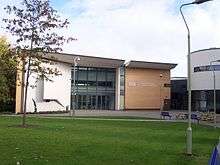
University College, Reading
The university owes its first origins to the Schools of Art and Science established in Reading in 1860 and 1870. In 1892 the College at Reading was founded as an extension college by Christ Church, a college of the University of Oxford. The first President was the geographer Sir Halford John Mackinder.[5] The Schools of Art and Science were transferred to the new college by Reading Town Council in the same year.[6][7]
The new college received its first treasury grant in 1901. Three years later it was given a site, now the university's London Road Campus, by the Palmer family of Huntley & Palmers fame. The same family supported the opening of Wantage Hall in 1908, and of the Research Institute in Dairying in 1912.[6]
University status
The college first applied for a Royal Charter in 1920 but was unsuccessful at that time. However a second petition, in 1925, was successful, and the charter was officially granted on 17 March 1926. With the charter, the college became the University of Reading, the only new university to be created in the United Kingdom between the two world wars.[6]
In 1947 the university purchased Whiteknights Park, which was to become its principal campus. In 1984 the University started a merger with Bulmershe College of Higher Education, which was completed in 1989.[6][8][9]
In October 2006, the Senior Management Board proposed[10] the closure of its Physics Department to future undergraduate application. This was ascribed to financial reasons and lack of alternative ideas and caused considerable controversy, not least a debate in Parliament[11] over the closure which prompted heated discussion of higher education issues in general.[12] On 10 October the Senate voted to close the Department of Physics, a move confirmed by the Council on 20 November.[13] Other departments closed in recent years include Music, Sociology, Geology, and Mechanical Engineering. The university council decided in March 2009 to close the School of Health and Social Care, a school whose courses have consistently been oversubscribed.[14][15]
In January 2008, the university announced its merger with the Henley Management College to create the university's new Henley Business School, bringing together Henley College's expertise in MBAs with the University's existing Business School and ICMA Centre. The merger took formal effect on 1 August 2008, with the new business school split across the university's existing Whiteknights Campus and its new Greenlands Campus that formerly housed Henley Management College.[16][17]
A restructuring of the university was announced in September 2009, which would bring together all the academic schools into three faculties, these being the Faculty of Science, the Faculty of Humanities, Arts and Social sciences, and Henley Business School. The move was predicted to result in the loss of some jobs, especially in the film, theatre and television department, which will shortly be moving into a brand new £11.5 million building on Whiteknights Campus.[18]
In late 2009 it was announced that the London Road Campus was to undergo a £30 million renovation, preparatory to becoming the new home of the university's Institute of Education. This is planned for completion in the summer of 2011, and is being partially funded by the sale of the adjoining site of Mansfield Hall, a former hall of residence, for demolition and replacement by private sector student accommodation.[19]
The university is a lead sponsor of UTC Reading, a new university technical college which opened in September 2013.[20][21]
In 2016 a move to reorganise the structure of Reading University provoked student protests.[22] On 21 March 2016, staff announced a vote of no confidence in the Vice Chancellor Sir David Bell.[23] 88% of those who voted backed the no confidence motion.[24]
Campuses
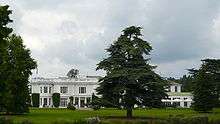
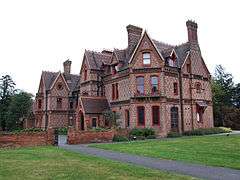
The university maintains over 1.6 square kilometres (395 acres) of grounds, in four distinct campuses:
- Whiteknights Campus, at 1.3 square kilometres (321 acres),[25] is the largest and includes Whiteknights Lake, conservation meadows and woodlands as well as most of the University's departments. The campus takes its name from the nickname of the 13th century knight, John De Erleigh IV or the 'White Knight', and was landscaped in the 18th century by the Marquis of Blandford. The main University library, in the middle of the campus, holds nearly a million books and subscribes to around 4,000 periodicals. It also has a lake, which is home to many Mandarin Ducks. The Whiteknights campus was voted one of the best green spaces in the United Kingdom for the fifth year running in the 2015 Green Flag People's Choice awards.[26]
- The smaller London Road Campus is the original university site and is closer to the town centre of Reading. The London Road site is home to The Institute of Education - one of the leading providers of teacher training in the UK. The Institute moved to its new home in January 2012. The campus was refurbished at a cost of £30 million, providing it with the best and most attractive facilities in the UK. The London Road site also plays host to the University graduation ceremonies twice a year, in the Great Hall.[27]
- The Greenlands Campus, on the banks of the River Thames in Buckinghamshire. Once the home of William Henry Smith, son of the founder of WH Smith, and latterly the site of the Henley Management College, this campus became part of the university on 1 August 2008, with the merger of that college with the university's Business School to form the Henley Business School. The school's MBA and corporate learning offerings will be based at Greenlands, with undergraduate and other postgraduate courses being based at Whiteknights.[17]
- An Asian campus at Iskandar, Malaysia was formally opened in February 2016.[28] It offers a range of professional programmes at foundation, undergraduate and postgraduate levels including the Henley Business School MBA.[29] First announced in October 2012, it is the university's first overseas campus. The project was overseen by Tony Downes.[30][31]
The former Bulmershe Court Campus in Woodley was the site of the former Bulmershe Teaching College, which merged with The University of Reading in 1989. The campus was sold in January 2014 as the University decided to concentrate its activity on its three other campuses. It had previously moved all teaching and research at Bulmershe either to Whiteknights or to London Road, and closed the student accommodation.
The university also owns 8.5 square kilometres (2,100 acres) of farmland in the nearby villages of Arborfield, Sonning and Shinfield. These support a mixed farming system including dairy cows, ewes and beef animals, and host research centres of which the flagship is the Centre for Dairy Research.
As part of the proposed Whiteknights Development Plan in Autumn 2007, the University proposed spending up to £250 million on its estates over 30 years, principally to focus academic activities onto the Whiteknights site.[32] The University also announced its intention to site some functions on the London Road site, and proposed a complete withdrawal from Bulmershe Court by 2012, which was accomplished.
Museums, libraries and botanical gardens
Reading University maintains four museums, a main campus library, a range of inter-departmental libraries, and a botanical garden. The largest and best known of these museums is the Museum of English Rural Life, which has recently relocated from a location on Whiteknights Campus to a site nearer the town centre next to the London Road Campus. The Ure Museum of Greek Archaeology, the Cole Museum of Zoology, the University of Reading Herbarium and the Harris Garden are all on the Whiteknights Campus.
The University Library at Whiteknights makes available over 1 million physical resources, as well as a range of electronic online resources, from 14,000 square metres of space across seven floors. The secondary site library at the University's Bulmershe Campus closed in 2011 and its operative collections were transferred. There is also a library in the University's Meteorology department.
Organisation and governance
- Faculty of Arts, Humanities and Social Science
- School of Arts and Communication Design
- Department of Art
- Department of Film, Theatre and Television
- Department of Typography and Graphic Communication
- Institute of Education
- School of Humanities
- Department of Classics
- Department of History
- Department of Philosophy
- School of Law
- School of Literature and Languages
- Department of English Language and Literature
- Department of Modern Languages and European Studies
- School of Politics, Economics and International Relations
- Department of Economics
- Department of Politics and International Relations
- International Study and Language Institute
- Faculty of Life Sciences
- School of Agriculture, Policy and Development
- School of Biological Sciences
- School of Chemistry, Food and Pharmacy
- Department of Chemistry
- Food and Nutritional Sciences
- The Reading School of Pharmacy
- School of Psychology and Clinical Language Science
- Department of Clinical Language Sciences
- Department of Psychology
- Faculty of Science
- School of Construction Management and Engineering
- School of Archaeology, Geography and Environmental Science
- Department of Archaeology
- Department of Geography and Environmental Science
- School of Mathematical, Physical and Computational Sciences
- Department of Mathematics and Statistics
- Department of Meteorology
- Department of Computer Science
Henley Business School
Henley Business School is a highly selective, top-ranking business school, among only 58 institutions worldwide (less than 1% of business schools globally) to be granted Triple accreditation by the three largest and most influential business school accreditation associations: EQUIS, AMBA and the AACSB. It includes several academic areas:
- Business Informatics, Systems and Accounting
- Leadership and Organisational Behaviours
- International Business and Strategy
- ICMA Centre[33]
- Real Estate and Planning
Graduate School
The university-wide Graduate School is a Faculty providing training and a range of support for doctoral researchers and related staff across the other four Faculties.
Governing bodies and roles
The university is nominally led by a Chancellor, who is the titular head of the university, and is normally a well-known public figure. The day-to-day chief executive role is the responsibility of the Vice-Chancellor, a full-time academic post. The senior management board of the university is headed by the Vice-Chancellor, assisted by a Deputy-Vice-Chancellor, three Pro-Vice-Chancellors, four Deans and five Heads of Directorate. It is responsible for the day-to-day management of the University and meets fortnightly throughout most of the year.[34]
The senior management board reports to the university's Senate, the main academic administrative body. The senate has around 100 members and meets at least four times a year and advises on areas such as student entry, assessment and awards. Membership includes Deans, Heads and elected representatives of Schools, as well as professional staff and students. The Senate in turn reports to the Council, which is the supreme governing body of the university, setting strategic direction, ensuring compliance with statutory requirements and approving constitutional changes. The Council meets four times a year, and comprises a broad representation of lay members drawn from commercial, community and professional organisations.[34]
On 24 March 2016 it was announced that William Waldegrave was to be the new Chancellor of Reading University.[35] Lord Waldegrave is the fourth Conservative politician to be appointed Chancellor of the University, following Austen Chamberlain, Sir Samuel Hoare and Lord Carrington. Waldegrave’s predecessor, Sir John Madejski is also a supporter of, and contributor to, the Conservative Party.[36]
Academic profile
Rankings and reputation
| ARWU[37] (2016, national) | 29–33 | |
|---|---|---|
| ARWU[38] (2016, world) | 301–400 | |
| QS[39] (2016/17, national) | 28 | |
| QS[40] (2016/17, world) | 175 | |
| THE[41] (2016/17, national) | 32 | |
| THE[42] (2016/17, world) | 192 | |
| Complete[43] (2017, national) |
27 | |
| The Guardian[44] (2017, national) |
32 | |
| Times/Sunday Times[45] (2017, national) |
31 | |
The 2014 Research Excellence Framework (REF), coordinated by the HEFCE, placed the University 27th out of 154 institutions in the UK for Research Power, and 19th for Research Intensity. In total, 98% of the University's research is labelled as 'internationally recognised', 78% as 'internationally excellent and 27% as 'world leading'.[46]
Departments in the University have been awarded the biannual Queen's Anniversary Prize for Higher and Further Education four times: in 1998, in the Humanities, Social Sciences and Law category, for work on Shakespeare; in 2005, in the Environment category; in 2008, again in Humanities, Social Sciences and Law; and in 2011, for "teaching and design applications in typography, through print and new technologies" in the Arts.[47]
Reading was the first university to win a Queen's Award for Export Achievement, in 1989.
The School of Agriculture Policy and Development was ranked top in the UK and 11th in the world, according to the QS classification of universities by subject.[48]
Finance
In recent years the university has been beset by controversy, with the closure of departments and job losses among staff.[13][14][15] The university lost 7.7% of its HEFCE funding in fiscal year 2010–2011.[49] In 2016 a move to reorganise the structure of Reading University provoked protests.[22]
Affiliated institutions
The Gyosei International College in the U.K. was established on property acquired from the University of Reading in 1989. The college, later renamed Witan International College, was acquired by the University of Reading in 2004.[50] Witan College closed in 2008.[51]
Student life
Reading University Students' Union (RUSU) is the affiliated student organisation which represents the students' interests. The university also has a number of Junior Common Rooms that are linked to the Students' Union. The Students' Union has been the launch pad for many political careers including Penny Mordaunt (MP for Portsmouth North), who was the 1994–5 President of the Students' Union.
The Students' Union runs the student radio station Junction11 Radio, an online student radio station. It also publishes Spark*, a newspaper aimed at the student population of the University, which is published fortnightly during term-time only and award winning student television station RU:ON.
The union provides a free advice service to students, and facilitates over 160 different activities for students to get involved in. The Students' Union building on Whiteknights Campus contains an 2500 capacity venue called 3sixty, with seven bars, and a number of retail outlets.
Halls and accommodation
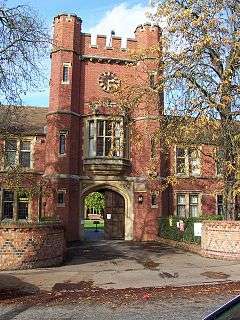
Student accommodation is provided in a number of halls of residence offering a mix of partially catered (19 meals per week) and self-catering accommodation, along with other self-catering accommodation. Following a major review the University is now proceeding with the integrated Halls and Catering Strategy, that will see several halls replaced as well as new ones created with social, catering & welfare facilities provided in hub areas.[52] Most of the halls of residence lie close to the northern campus periphery and in residential areas close by.
Halls are managed in the following groups: Lakeside, comprising Bridges, Bulmershe and Wessex; Northcourt, comprising Sibly, Sherfield, Benyon and St Patrick's Hall; Park, comprising Childs, Greenow, McCombie, Mackinder, Stenton, Windsor and Dunsden Crescent; Redlands, comprising Hillside, Martindale, St. George's, St Andrew's (formerly), Wells and Wantage; and Estates Management, comprising 35 Upper Redlands Road, Mansfield and St. David's. Other privately managed halls include Kendrick Hall and Crown House (by Unite Students), Saxon Court Apartments (by Collegiate AC), Loddon House and Kings Road (by Fawley Bridge Student Accommodation) and Reading Central Studios (by Fresh Student Living).[53] Wantage Hall is thought to be the oldest purpose built hall in England[54] outside of 'Oxbridge' and is built in the style of an 'Oxbridge' college.
St. Andrews Hall closed in 2001, and is now the home of the Museum of English Rural Life.[55]
St. George's Hall and the Reading Student Village (renamed Benyon) are leased back to the University from UPP. The cost of leasing back the Student Village to the University, according to the University accounts, was £1.3 million in 2002–03 and £1.5 million for 2003–04.
In 2011 the management of the mature and international halls, Hillside and Martindale, was taken over by the "Estates management team", as was Bulmershe Hall in 2012, the sale of which was finalised in 2014.[56] In the same year the new Kendrick Halls were opened on the ground of halls which had not been in use for many years. These are not managed by the university.
In 2012, UPP and the University announced that they would be redeveloping Bridges Hall and Sibly Hall.[57][58] Bridges Hall reopened for the 2014–15 academic year.[59]
Working with business
Reading hosts a number of private sector businesses on its campuses, either occupying dedicated buildings or in managed space at the Science & Technology Centre or Enterprise Hub.
Science & Technology Centre
The University of Reading Science & Technology Centre is situated on the eastern side of Whiteknights Campus. The Science & Technology Centre supports and accommodates technology companies from start-up through to larger SMEs.[60][61][62]
Notable companies currently or previously based at the Science & Technology Centre[63][64] include Reading Scientific Services Ltd.
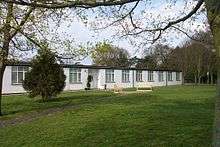
Reading Enterprise Hub
Reading Enterprise Hub is a business incubator opened in 2003. The hub was jointly sponsored by the university and SEEDA, and sought to attract startup high tech companies, particularly those with interests in environmental technology, information technology, life sciences, and materials science.[65]
The hub was originally situated in World War II era temporary office buildings on the university's Whiteknights campus. During the summer of 2008 the hub was demolished, along with the neighbouring former agriculture buildings, and the remaining tenants relocated to a building on the London Road campus. As of April 2010, a new Reading Enterprise Centre is being constructed on the hub's original site.[66]
Dedicated buildings
Besides its use of the Science & Technology Centre, Reading Scientific Services also occupies the Reading Science Centre, situated on the eastern side of Whiteknights campus.[67]
Officers
Principals of University College, Reading
- Sir Halford John Mackinder (1892–1903)[5][68]
- William Macbride Childs (1903–1926)[5][69]
Chancellors of the University of Reading
- J. H. Benyon (1926–1935)[70]
- Sir Austen Chamberlain (1935–1937)[70]
- Sir Samuel Hoare (1937–1959)[70]
- Lord Bridges (1959–1969)[70]
- Sir Roger Makins (1970–1992)[70]
- Lord Carrington (1992–2007)[70][71]
- Sir John Madejski (2007–2016)[70][71]
- William Waldegrave (2016–)[72]
Vice-Chancellors of the University of Reading
- William Macbride Childs (1926–1929)[69]
- Sir Franklin Sibly (1929–1946)[73]
- Sir Frank Stenton (1946–1950)[74]
- Sir John Wolfenden (1950–1963)[75]
- Sir Harry Raymond Pitt (1964–1978)[76]
- Ewan Page (1979–1993)[77][78]
- Sir Roger Williams (1993–2002)[79]
- Gordon Marshall (2003 – July 2011)[80][81]
- Tony Downes (acting; July 2011 – January 2012)[82]
- Sir David Bell (January 2012–)[82]
Notable academics
- Stanislav Andreski – was a professor of Sociology at the University of Reading
- Malcolm Barber – Emeritus Professor of History, University of Reading
- Dianne Berry – Professor of Psychology and Dean of Postgraduate Research Studies at the University of Reading
- William de Burgh – Professor of Philosophy, University of Reading
- Mark Casson – Professor of Economics, University of Reading[83]
- Francis Cole - Professor of Zoology, University of Reading
- Howard Colquhoun – Professor of Materials Chemistry, University of Reading
- John Cottingham – Emeritus Professor of Philosophy, University of Reading
- Neil Crosby – Professor of Real Estate, University of Reading
- Jonathan Dancy – Professor of Philosophy, University of Reading
- Michael Drew – Professor of Chemistry, University of Reading
- Antony Flew – Emeritus Professor of Philosophy, University of Reading
- Sir Terry Frost – was Professor of Fine Art, University of Reading
- Michael Fulford – Professor of Archaeology and Pro-Vice-Chancellor of the University of Reading
- Colin S. Gray – Professor of International Relations and Strategic Studies, University of Reading
- Edward Guggenheim – was a thermodynamicist and professor of chemistry at the University of Reading
- Andrew Gurr – was a professor of English at the University of Reading until his retirement and is a leading authority on Shakespeare
- Beatrice Heuser – Professor of International Relations, University of Reading
- Gustav Holst – was a professor of Music at University College, Reading
- Harold Hopkins – was a professor of Applied Physical Optics at the University of Reading
- Sir Brian Hoskins – Professor of Climatology, University of Reading and Director of the Grantham Institute for Climate Change, Imperial College London
- Michael Lockwood - Professor of Space Environment Physics, University of Reading
- William Burley Lockwood – Professor of Germanic and Indo-European Philology 1968–1982
- J-P Mayer - Professor Emeritus, editor of the works of Alexis de Tocqueville and founder of the Tocqueville Research Centre at the University
- Roger W. Mills – Emeritus Professor of Finance, University of Reading
- Edith Morley - Professor of English, University College, Reading: the first woman appointed (1908) to a chair at a British university-level institution.[84]
- Crispin St. J. A. Nash-Williams – was a professor of Mathematics at the University of Reading
- Frank R. Palmer - Emeritus Professor of the Linguistic Science, University of Reading
- Richard Rado – was a professor of Mathematics at the University of Reading
- Peter Robinson – poet, poetry editor at Two Rivers Press, and Professor of English and American literature at the University of Reading
- Hugh Macdonald Sinclair – pioneer of human nutrition and visiting professor in Food Science at the University of Reading
- Keith Shine – Professor of Climatology, University of Reading
- Sir Frank Stenton – was a professor of History at the University of Reading
- Galen Strawson – Professor of Philosophy, University of Reading
- Percy and Annie Ure – husband and wife team. Percy was the first professor of classics at Reading and Annie was the curator of the Ure Museum of Greek Archaeology
- Andrew Wallace-Hadrill – Director of the British School at Rome and professor of Classics, University of Reading
- Kevin Warwick – Professor of Cybernetics, University of Reading
Notable alumni
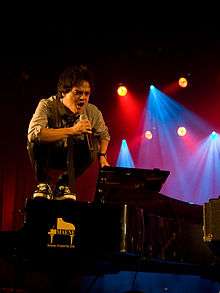
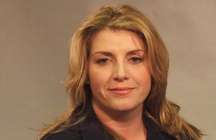

Academics
- Ash Amin – Professor of Geography, University of Cambridge
- Janet Beer – Vice-Chancellor of the University of Liverpool (formerly Vice-Chancellor of Oxford Brookes University)
- L. J. F. Brimble – botanist and editor of Nature magazine
- Sir Clifford Charles Butler – co-discoverer of hyperons and mesons, Professor of Physics at Imperial College London, Vice-chancellor of Loughborough University
- Stephen E. Calvert – Emeritus Professor of Geology, University of British Columbia
- David Carpanini – Emeritus Professor of Art, University of Wolverhampton
- Michael Cox – Professor of International Relations, London School of Economics
- Sir Peter Crane – Professor of Botany, Yale University
- Beate Hermelin (1920–2008) – German-born experimental psychologist, who worked in the UK
- Sean Holly – Professor of Economics, University of Cambridge
- Jolyon Howorth – Professor of European politics, University of Bath and Visiting Professor of Political Science at Yale University
- Michael Leifer – was a professor of International Relations, London School of Economics
- David Marks – Professor of Psychology, City University London
- Dragan Marušič – Professor of Mathematics at the University of Ljubljana
- Avi Shlaim – Professor of International Relations, University of Oxford
- June Thoburn – Emeritus Professor of Social Work at the University of East Anglia
- Ethelwynn Trewavas – ichthyologist and taxonomist
- John Turner – Professor of Engineering and Pro-Vice Chancellor of the University of Portsmouth
- A. E. Wilder-Smith – creationist and chemist
Broadcasting
- Julian Barratt – comedian, BBC's The Mighty Boosh
- Keith Bosley – former BBC broadcaster and prizewinning poet and translator
- Richard Holmes – military historian and television presenter
- Kaddy Lee-Preston – TV weather presenter
- Julian Richards – archaeologist and broadcaster
- Richard Sambrook – Director of the BBC World Service
- Tomasz Schafernaker – TV weather presenter
- Nick Thorpe – BBC Central Europe correspondent (1996–); formerly BBC Budapest correspondent
- Laura Tobin – TV weather presenter
- Jay Wynne – TV weather presenter
Business
- David Atkins – Chief Executive, Hammerson plc
- Nick Candy – Co-Founder and partner of high end property development company, Candy & Candy, London
- Gavin Grant – Chief Executive of the Royal Society for the Prevention of Cruelty to Animals
- Nicky Kinnaird – founder and president of British cosmetic retailer Space NK
- Robert Noel – businessman, Chief Executive of Land Securities Group plc
Military
- Lieutenant-Colonel Rupert Thorneloe, Welsh Guards officer killed in action in Afghanistan
Music
- Arthur Brown – rock and roll singer
- Alan Clayson – singer, composer, record producer, leader of the band Clayson and the Argonauts
- Jamie Cullum – jazz pianist and singer
- Falz - Nigerian Musician and actor
- Liam Howe – music producer, musician, formed the band Sneaker pimps with David Westlake and Joe Wilson (musician) also alumni
- Hilary James – singer, double bassist, guitarist, and mando-bassist
- Andy MacKay – member of the band Roxy Music
- Simon Mayor – mandolinist, fiddle player, guitarist, and composer
- Martin Noble – musician, Noble in the band British Sea Power
- Edmund Rubbra – composer
- Julian Wagstaff – composer
- Scott Wilkinson – musician and composer, Yan in the band British Sea Power
Politics
- Anton Apriantono – food technology scientist, serving as Indonesia's Minister of Agriculture since 2004
- Dimeji Bankole – Nigerian politician and Speaker of the House of Representatives of Nigeria
- Fred Gardiner – Canadian politician who took an officer's course at Reading during World War I
- Edison James – Prime Minister of Dominica 1995–2000, Leader of the Opposition, 1990–1995 and 2000–2007
- Shukuru Kawambwa – Tanzanian Minister of Education and Vocational Training
- Jan Kavan – Czech diplomat and politician
- Penny Mordaunt – Conservative Member of Parliament for Portsmouth North
- Mike Penning – Conservative Member of Parliament for the Hemel Hempstead parliamentary constituency
- Frauke Petry – German Politician
- Hugh Robertson – Conservative Member of Parliament for Faversham and Mid Kent
- Ibrahim Taguri - British community worker and political candidate
- Rob Wilson – Conservative Member of Parliament for the Reading East parliamentary constituency
Sport
- David Bedford (athlete) – runner
- Cath Bishop – rower, silver medallist in the coxless pairs at the 2004 Olympics
- James Cracknell – rower, gold medallist in the coxless fours at the 2000 Olympics and 2004 Olympics
- Debbie Flood – rower, silver medallist in the quadruple sculls at the 2004 Olympics
- Alex Gregory - rower, gold medallist in the coxless fours at the 2012 Olympics
- Gary Herbert – rower, gold medallist in the coxed pairs at the 1992 Olympics
- Molly Hide – cricketer, captained the English women's team for seventeen years
- Will Hoy – racing driver, British Touring Car Champion in 1991
- Bill Lucas - rower
- Anna Watkins – rower, gold medallist in the double sculls at the 2012 Olympics
Writing and art
- Steven Atkinson – theatre director, and artistic director of HighTide Festival Theatre
- Anne Bean – installation and performance artist
- Vincent Connare – creator of Comic Sans
- Jeff Evans – beer writer
- Robert Gillmor – ornithologist, artist, illustrator, author and editor
- Kathleen Hale – artist and children's author, the Orlando the Marmalade Cat series
- Alan Morrison - poet
- Mike Nelson – installation artist
- Wilfred Owen – war poet
- Joan Smith – novelist and journalist
- David Watkins – designer of the London 2012 Olympics medals
- Richard Wilson – installation artist
Others
- Eve Balfour – farmer, educator, organic farming pioneer, and a founding figure in the organic movement
- Robin Bextor – film and television director, father of Sophie Ellis-Bextor
- Azahari Husin – leading member of the Jemaah Islamiyah group, believed to have been involved in the 2005 Bali bombing
- Clive Ponting – civil servant who faced trial for the leaking of information on the sinking of the Belgrano, during the Falklands War
- John Tabatabai – professional poker player[85]
- Wei Tang – actress, Ang Lee's Lust, Caution[86]
- Rachel Treweek – Bishop of Gloucester; the first female diocesan bishop in the Church of England,[87] and the first female Lord Spiritual
- Carl Wright - civil servant former director of the Commonwealth Trade Union Group and Secretary-General of the Commonwealth Local Government Forum
See also
References
- ↑ "Financial Statements for the year ended 31 July 2015" (PDF). University of Reading. p. 31. Retrieved 10 December 2015.
- 1 2 3 "2014/15 Students by HE provider, level, mode and domicile" (XLSX). Higher Education Statistics Agency. Retrieved 19 January 2016.
- ↑ "University of Reading". University of Reading. Retrieved 2015-09-23.
- ↑ "University of Reading". Retrieved 2015-09-23.
- 1 2 3 Corley, T.A.B. "Childs, William Macbride (1869–1939), educationist". Oxford Dictionary of National Biography. Oxford University Press. Retrieved 8 February 2010.
- 1 2 3 4 "The University's History". University of Reading. Retrieved 30 April 2009.
- ↑ "The University of Reading is 85 years old". University of Reading. 16 March 2011. Retrieved 21 March 2011.
- ↑ "Campus Architecture". University of Reading. Retrieved 24 July 2007.
- ↑ "Statutory Instrument 1989 no. 408". Opsi.gov.uk. Retrieved 28 May 2010.
- ↑ Official statement about the Physics Department on the University website
- ↑ "Information page of Labour MP for Reading West, Martin Salter". Archived from the original on 21 June 2008. Retrieved 6 October 2014.
- ↑ Official Statement about University Senate vote from University website
- 1 2 "article concerning the confirmed closure of the Physics department". BBC News. 21 November 2006. Retrieved 28 May 2010.
- 1 2 Melanie Newman, "Institutions draw up plans for closures and job losses", Times Higher Education, 19 February 2009
- 1 2 Melanie Newman, "Alarm grows as jobs to go at four more institutions", Times Higher Education, 26 March 2009
- ↑ "World-class business school to be created as University of Reading merges with Henley Management College". University of Reading. 9 January 2008.
- 1 2 "Briefing News Update – Henley Business School". University of Reading. Summer 2008.
- ↑ Fearn, Hannah (11 September 2009). "Reading plans restructuring". Times Higher Education.
- ↑ "University announces £30 million development of historic London Road campus". University of Reading. 10 December 2009. Retrieved 21 March 2011.
- ↑ "Partners - UTC". Utcreading.co.uk. Retrieved 17 July 2013.
- ↑ "High-tech education at Reading's first technical college". Reading Chronicle. 17 September 2013.
- 1 2 Hyde, Nathan. "Cost-cutting review slammed by University of Reading student". getreading. Retrieved 2016-03-13.
- ↑ Hyde, Nathan. "University of Reading vice chancellor faces vote of no confidence". getreading. Retrieved 2016-03-29.
- ↑ "'No confidence' in University of Reading vice-chancellor". bbc. Retrieved 2016-05-03.
- ↑ "Campus life for students". University of Reading. Retrieved 17 November 2010.
- ↑ "University of Reading campus voted one of the UK's best green spaces". Get Reading. Retrieved 9 October 2015.
- ↑ http://www.reading.ac.uk/education/about/ioe-about.aspx
- ↑ "University of Reading's £25m Malaysia campus officially opens". BBC News Online. 2016-02-25. Retrieved 2016-03-02.
- ↑ "The University of Reading Malaysia - about us". The University of Reading Malaysia. Retrieved 2016-03-02.
- ↑ "University of Reading Malaysia appoints Provost". reading.ac.uk. 23 October 2012.
- ↑ "University of Reading Malaysia". reading.ac.uk.
- ↑ "Whiteknights development plan" (PDF). University of Reading. Retrieved 9 March 2008.
- ↑ Department of Finance associated with ICMA Centre
- 1 2 "Governance of the University of Reading". University of Reading. Retrieved 24 July 2007.
- ↑ "Lord Waldegrave named as Reading University chancellor", BBC News, 24 March 2016
- ↑ "Tory donor in leadership call". Daily Mail. London.
- ↑ "Academic Ranking of World Universities 2016 - UK". Shanghai Ranking Consultancy. Retrieved 15 August 2016.
- ↑ "Academic Ranking of World Universities 2016". Shanghai Ranking Consultancy. Retrieved 15 August 2016.
- ↑ "QS World University Rankings 2016/17 - United Kingdom". Quacquarelli Symonds Ltd. Retrieved 7 September 2016.
- ↑ "QS World University Rankings 2016/17". Quacquarelli Symonds Ltd. Retrieved 7 September 2016.
- ↑ "World University Rankings 2016-17 - United Kingdom". Times Higher Education. Retrieved 21 September 2016.
- ↑ "World University Rankings 2016-17". Times Higher Education. Retrieved 21 September 2016.
- ↑ "University League Table 2017". The Complete University Guide. Retrieved 25 April 2016.
- ↑ "University league tables 2017". The Guardian. 23 May 2013. Retrieved 23 May 2016.
- ↑ "The Times and Sunday Times University Good University Guide 2017". Times Newspapers. Retrieved 23 September 2016.
- ↑ "Research facts and figures". The University of Reading.
- ↑ "Previous Prize-winners: The University of Reading". The Royal Anniversary Trust.
- ↑ "QS World University Rankings by Subject 2014 - Agriculture & Forestry". QS.
- ↑ Melanie Newman, "Teaching and research escape 9% grant cut", Times Higher Education, 18 March 2010
- ↑ "The University of Reading and Witan International College." (Archive) University of Reading. 6 August 2004. Retrieved on 9 January 2014.
- ↑ "Witan International College." (Archive) University of Reading. Retrieved on 9 January 2014.
- ↑ "Halls Redevelopment Information". University of Reading. p. 1. Retrieved 21 February 2009.
- ↑ "Student Private Halls in Reading". Retrieved 26 October 2015.
- ↑ Aberdare Hall in Cardiff (formerly University College of South Wales and Monmouthshire, now Cardiff University) would appear to predate it.
- ↑ "The History of St. Andrew's Hall". Online Exhibitions. The Museum of English Rural Life. Retrieved 11 January 2011.
- ↑ "University finalises sale of Bulmershe campus". University of Reading. 21 January 2014. Retrieved 26 October 2015.
- ↑ "Partners agree terms for the renewal of Bridges Hall at the University of Reading". Property Magazine International. 20 August 2012. Retrieved 9 February 2014.
- ↑ "Sibly Hall Redevelopment" (PDF). University of Reading. 2012. Retrieved 26 October 2015.
- ↑ "Bridges Hall Redevelopment". University of Reading. Retrieved 9 February 2014.
- ↑ "Science & Technology Centre – Business Zone". University of Reading. Retrieved 21 April 2007.
- ↑ "University of Reading Science and Technology Centre and Enterprise Hub". UKSPA. Retrieved 29 October 2009.
- ↑ "Science Parks in Europe". UNESCO. Retrieved 29 October 2009.
- ↑ "Science & Technology Centre – Companies". University of Reading. Retrieved 21 April 2007.
- ↑ "Science & Technology Centre – Companies". University of Reading. Retrieved 23 September 2009.
- ↑ "Reading Enterprise Hub". University of Reading. Archived from the original on 25 September 2006. Retrieved 7 April 2010.
- ↑ "Facilities for Business at the University of Reading". University of Reading. Retrieved 7 April 2010.
- ↑ "Main Site Map" (PDF). Reading Scientific Services Ltd. Retrieved 10 November 2009.
- ↑ Ian Macrae, "The making of a university, the breakdown of a movement: Reading University Extension College to The University of Reading, 1892–1925", Journal International Journal of Lifelong Education, Volume 13, Issue 1 January 1994, pages 3–18
- 1 2 "University of Reading Bulletin (16 March 2006)" (PDF). University of Reading. p. 4. Archived from the original (PDF) on 8 March 2008. Retrieved 24 July 2007.
- 1 2 3 4 5 6 7 "Reading welcomes its new chancellor". Bulletin. University of Reading. 17 January 2008. pp. 6–7.
- 1 2 "Football boss made uni chancellor". BBC. 11 July 2007. Retrieved 24 July 2007.
- ↑ "University of Reading selects new Chancellor". 24 March 2016. Retrieved 10 October 2016.
- ↑ "Halls Booklet" (PDF). University of Reading. p. 12. Retrieved 24 July 2007.
- ↑ "University of Reading Bulletin (20 November 2008)" (PDF). University of Reading. p. 3. Retrieved 20 November 2008.
- ↑ "Papers of Lord Wolfenden". University of Reading. Retrieved 21 November 2008.
- ↑ Sewell, Michael (2 February 2006). "Tribute to Sir Harry Raymond Pitt, F.R.S." (PDF). Retrieved 12 March 2008.
- ↑ "Apply again, funding council tells universities". Times Higher Education Supplement. TSL Education Limited. 21 July 1995. Retrieved 5 October 2010.
- ↑ "First Vice-Chancellor for computer profession" (PDF). The Computer Journal. Oxford Journals / Oxford University Press. Retrieved 5 October 2010.
- ↑ "Professor Sir Roger Williams". University of Glamorgan. Archived from the original on 9 March 2009. Retrieved 6 January 2009.
- ↑ "Professor Gordon Marshall". University of Reading. Retrieved 24 July 2007.
- ↑ "Farewell Vice-Chancellor". University of Reading. Retrieved 29 July 2011.
- 1 2 "Introducing our new Vice-Chancellor". University of Reading. Retrieved 17 October 2011.
- ↑ "Professor Mark Casson - University of Reading". Retrieved 6 October 2014.
- ↑ Law, Cheryl (2004). "Morley, Edith Julia (1875–1964)". Oxford Dictionary of National Biography. Oxford University Press. Retrieved 2011-02-14. (subscription or UK public library membership required)
- ↑ Deal or no deal? by Robert Blincoe, thegoodgamblingguide.co.uk 19 July 2008. Archive here
- ↑ "HKMD Daily News, February 25, 2009". Hkmdb.com. Retrieved 28 May 2010.
- ↑ "Introducing Bishop Rachel". About the Diocese. Diocese of Gloucester. Retrieved 9 April 2016.
External links
| Wikimedia Commons has media related to University of Reading. |
Coordinates: 51°26′31″N 0°56′44″W / 51.44194°N 0.94556°W
